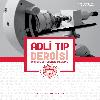Adli tıp açısından malpraktise yaklaşım - arteryel anevrizma rüptürü olan bir olgu
Approach to malpractice in terms of forensic medicine a case with arterial aneurysm rupture
___
- 1. Rasmussen BA. Epidemiology of headache. Cephalalgia 2001; 21:774-777.
- 2. Pryse-Phillips W, Findlay H, Tugwell P, Edmeads J. A Canadian population survey on the clinical, epidemiological and societal impact of migraine and tension type headache. Can J Neurol Sci 1992; 19:333-339.
- 3. Stewart WF, Lipton RB, Simon D. Work-related disability: results from the American Migraine Study. Cephalalgia 1996; 16:231-238.
- 4. Pesa J, Lage MJ. The medical costs of migraine and comorbid anxiety and depression. Headache 2004; 44:562-570.
- 5. Jensen R, Stovner LJ. Epidemiology and comorbidity of headache. Lancet Neurol 2008;7:354-61.
- 6. Stovner LJ, Hagen K, Jensen R, Katsarava Z, Lipton R, Scher A, et al. The global burden of headache: a documentation of headache prevalence and disability worldwide. Cephalalgia 2007;27:193-210.
- 7. Lipton RB, Bigal ME. The epidemiology of migraine. Am J Med 2005;118[suppl 1]:3-10S.
- 8-Olesen J, Steiner TJ. The international classification of headache disorders. 2nd ed [ICDH-II]. J Neurol Neurosurg Psychiatry 2004;75:808-11.
- 9. Abu-Arefe I, Russell G. Prevalence of headache and migraine in school children. Br Med J 1994; 309:765-769.
- 10. Ozge A, Bugdayci R, Sasmaz T, Kaliagası H, Kurt O, Karakelle H, et al. The sensitivity and specifity of the case definition criteria in diagnosis of headache: a school based epidemiological study of 5562 children in Mersin. Cephalalgia 2002; 22:791-798.
- 11. Lance JW. Mechanism and Management of Headache. Oxford, BH, 1998;158- 175.
- 12. Olsen J, Tfelt-Hansen P, Welch KMA. The Headaches. New York, Raven Press, 1993; 437-543.
- 13. Kurth T, Gaziano JM, Cook NR, Logroscino G, Diener HC, Buring JE. Migraine and risk of cardiovascular disease in women. JAMA 2006;296:283-91.
- 14. Bigal ME, Kurth T, Santanello N, Buse D, Golden W, Robbins M, et al. Migraine and cardiovascular disease: a population-based study. Neurology 2010;74:628-35.
- 15. Gudmundsson LS, Scher AI, Aspelund T, Eliasson JH, Johannsson M, Thorgeirsson G, et al. Migraine with aura and risk of cardiovascular and all cause mortality in men and women: prospective cohort study. BMJ 2010;341:3966.
- 16. Kruit MC, Launer LJ, Ferrari MD, van Buchem MA. Infarcts in the posterior circulation territory in migraine. The population- based MRI CAMERA study. Brain 2005;128:2068-77.
- 17. Scher AI, Gudmundsson LS, Sigurdsson S, Ghambaryan A, Aspelund T, Eiriksdottir G, et al. Migraine headache in middle age and late-life brain infarcts. JAMA 2009;301:2563-70.
- 18. Dufouil C, de Kersaint-Gilly A, Besancon V, Levy C, Auffray E, Brunnereau L, et al. Longitudinal study of blood pressure and white matter hyperintensities: the EVA MRI cohort. Neurology 2001;56:921-6.
- 19. Silberstein SD, Lipton RB, Goadsby PJ, Headache in clinical practice. 2nd ed. London, England:Martin Dunitz Ltd, 2002.
- 20. Ricardo E. Jorge, Jorge E. Leston, Stephan Arndt, Robert G. Robinson. Cluster headaches: Association with anxiety disorders and memory deficits. Neurology August 1, 1999; vol. 53; 3- 543
- 21. Çetinkaya Y, Tireli H. Bingöl ilinde Nöroloji Polikliniğine Başvuran Hastalarda Baş Ağrısı Sıklığı NöroPsikiyatri Arşivi 2005;42[1-4]:9-11
- 22. Lipton LB, Silberstein SD. The role of headache related disability in migraine management:implications for headache treatment guidelines. Neurology. 2001; 56 [1]: 35-42.
- 23. Rasmussen BK. Tension type headache, clusterheadache and miscellaneous headaches, epidemiology. J Olsen, P Tfelt-Hansen, KMA Welch [eds.], The Headaches, New York, Raven Press,1993;439.
- 24. Cooney BS, Grossman RI, Farber RE, Goin JE, Galetta SL. Frequency of magnetic resonance imaging abnormalities in patients with migraine. Headache 1996;36:616-21.
- 25. Swartz RH, Kern RZ. Migraine is associated with magnetic resonance imaging white matter abnormalities: a metaanalysis. Arch Neurol 2004;61:1366-8.
- 26. Igarashi H, Sakai F, Kan S, Okada J, Tazaki Y. Magnetic resonance imaging of the brain in patients with migraine. Cephalalgia 1991;11:69-74.
- 27. De Benedittis G, Lorenzetti A, Sina C, Bernasconi V. Magnetic resonance imaging in migraine and tension-type headache. Headache 1995;35:264-8.
- ISSN: 1018-5275
- Başlangıç: 1985
- Yayıncı: BAYT Yayıncılık
Av tüfeği namlu uzunluğunun saçma dağılımına etkisi ve atış mesafesinin belirlenmesinde önemi
Cengiz BAL, Yasemin BALCI, Adnan ÇELİKEL, Bülent ÜNER
Eskişehir'de mahkemeye yansıyan cinsel taciz olguları
Yasemin BALCI, Tarık GÜNDÜZ, Kenan KARBEYAZ, Harun AKKAYA
Kimliklendirme için kulak kepçesi morfolojisinin kullanılabilirlik sınırlarının tanımlanması
Mahmut AŞIRDİZER, Mehmet Sunay YAVUZ, Beyhan ÖZYURT, Ertuğrul TATLISUMAK
Belçika'da yaşayan Türklerin ötanaziye yaklaşımı
Virtopsinin adli otopsideki yeri ve önemi
Celal BÜTÜN, Fatma Yücel BEYAZTAŞ, Muharrem ÇELİK
Adli tıp açısından malpraktise yaklaşım - arteryel anevrizma rüptürü olan bir olgu
Gürol BERBER, Muhammed Nabi KANTARCI, Mustafa BALKAY, Eyüp KANDEMİR
Sarsılmış bebek sendromu (shaken baby) sonucu ölüm; olgu sunumu
Yasemin BALCI, Tarık GÜNDÜZ, Sabiha ŞAHİN, Kenan KARBEYAZ, Harun AKKAYA
Sağlık çalışanlarının çocuk istismarı ve ihmali konusundaki farkındalık düzeylerinin ölçülmesi
